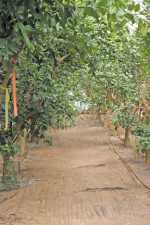Florida Citrus Nurseries Running At Full Capacity

Despite grower frustrations and concerns with tree decline and fruit drop, many — if not all — Florida citrus nurseries continue to operate at capacity. Growers who were (in years past) accustomed to rapid fulfillment of tree orders find themselves placing deposits and entering a queue that stretches from one to three years. Many nurseries have sold their DPI-certified screenhouse capacity three years out. This raises another significant question in the recovery of the industry: covering short-term resets, block replacement, and more long-term recommitment of acreage when truly viable tools are employed in the fight against HLB. Will Florida have sufficient nursery capacity to prevent the dreaded loss of critical mass in fresh and processed sectors? Reflecting on the annual report published by the Bureau of Citrus Budwood Registration, Florida certified citrus nurseries have produced fewer than half of the trees needed to sustain a restoration of lost acreage.
No Room For Error
Despite the depleted capacity of the Florida citrus nursery segment, interviews conducted roughly 18 months ago revealed very little willingness on the part of nurseries to expand capacity. At that time, nursery owner/operators having built modular and easily expandable facilities remained averse to the assumption of more risk in the face of HLB. Even though several nursery owners felt they could double capacity and reach full utilization through new orders almost overnight, very few would commit to expansion. The risk was simply too great. Adding pressure to the equation, it would take nurseries several years to increase budwood and liner supplies to a level necessary to supply additional capacity. These hard realities were rapidly becoming the next impediment to recovery.
Pressure Relief
Thankfully, the situation appears to be changing quickly — and for the better. Since mid January, 15 nurseries have applied for permits to build new sites. Four of these are now in production; two are very close to production and may be in production by presstime); five are in the planning stages; and four are a long-shot to follow through. Florida presently has 42 commercial nurseries in production (including private nurseries producing trees for a single entity). This figure does not include research nurseries or those purely engaged in production for the dooryard segment.
In 2012, 14 of the 42 commercial nurseries expanded their capacity. It is roughly estimated that the expansion of the 42 will equate to another 500,000 trees. Clearly, most of this capacity will be committed to processing oranges. However, the increased capacity should benefit both the processed and fresh sectors. This added capacity will come online at various stages over the next 18 months. Florida should hit 4 million trees of screenhouse production this year and perhaps as much as 4.5 to 5 million the following year. Though this is not where we ultimately need to be, it does signify a step in the right direction and it does provide more evidence of the resilience, optimism, and staying power of the industry. The recommitment of the nursery sector mirrors the commitment of the Florida citrus grower. In the face of immense challenges, this is welcomed news indeed.
One final note that should add momentum to the changes described above. If the legislature follows through with funding support that will better enable DPI to supply the budwood needs of Florida commercial nurseries (supplementing private budwood production), our position will improve considerably.










